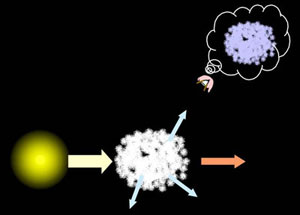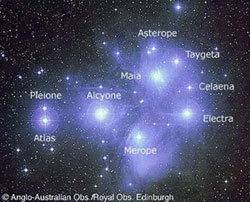Reflection Nebula

A reflection nebula is created when light from a star is scattered or reflected off a neighbouring dust cloud. The scattered light is slightly polarised and has a spectrum similar to that of the illuminating star, only bluer. This shift in colour arises because the typical size of dust grains in the cloud are comparable to the wavelength of blue light. The result is that blue light is scattered more efficiently than longer, red wavelengths giving the characteristic blue colour for these nebulae.
| Reflection nebulae are usually less dense than dark nebulae, and have sizes that are determined by the source of illumination. Their extent is not defined by the size of the dust cloud but rather the area over which their brightness remains above the point of detection. The nebulosity surrounding the stars in the Pleiades is perhaps the most well known example of a reflection nebula. |
Study Astronomy Online at Swinburne University
All material is © Swinburne University of Technology except where indicated.


